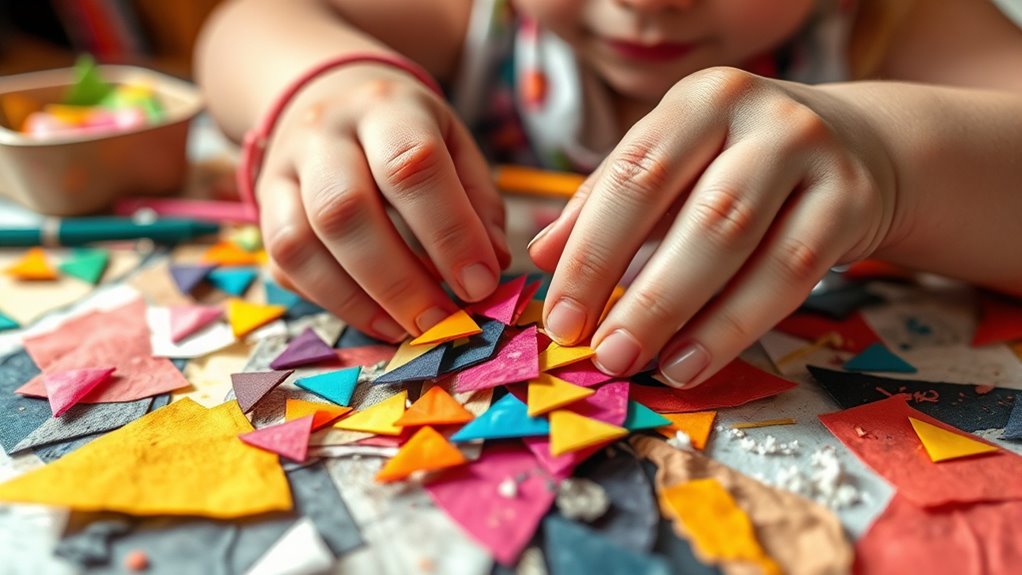To build fine motor skills with collage, focus on techniques like tearing, cutting, and gluing textured papers and materials. Handling different surfaces promotes grip strength and finger control, while layering and blending colors require precise movements. Manipulating various materials challenges your hand-eye coordination and steadiness. Repeated cutting and shaping improve dexterity, and engaging with diverse textures makes activities more stimulating. Keep exploring these methods, and you’ll discover even more ways to enhance fine motor development.
Key Takeaways
- Incorporate textured materials like fabric scraps and foil to enhance tactile exploration and finger strength.
- Use precise cutting and tearing activities to improve hand control and pincer grip development.
- Practice layering and blending colors to promote deliberate movements and fine motor coordination.
- Include handling different materials such as cardboard and paper to diversify grip techniques and adaptability.
- Engage in glue application and placement tasks to strengthen pressure control and precision in small movements.

Have you ever wondered how creating collages can boost fine motor skills? When you engage in collage-making, you’re not just assembling pretty pictures; you’re actively developing hand-eye coordination, dexterity, and control. One of the exciting ways to enhance these skills is through texture exploration. As you pick up various materials—ripped paper, fabric scraps, textured foil—you challenge your fingers to grasp, feel, and manipulate different surfaces. This tactile experience helps strengthen the small muscles in your hands and fingers, improving overall precision and control. Handling diverse textures encourages you to refine your grip and develop better finger strength, essential for everyday tasks like writing, buttoning, or tying shoelaces.
Alongside texture exploration, another vital aspect is color mixing. When you decide to layer different colored papers or blend hues to create new shades, you’re engaging in fine motor activities that require deliberate movements. Cutting, tearing, or tearing paper into specific shapes demands careful control, fostering hand steadiness. Moving pieces precisely into place involves sustained focus and precise finger movements, which gradually improve your fine motor dexterity. As you experiment with color mixing in your collage, you also stimulate your visual and cognitive skills, making the process both creative and beneficial for motor development.
Layering and blending colors in collages enhance fine motor control and stimulate visual and cognitive growth.
Using scissors or glue adds an extra layer of skill-building. When you cut out shapes or glue pieces onto your base, you practice controlled hand movements. Cutting along lines requires steady pressure and accurate hand coordination, strengthening your pincer grip—a critical component of fine motor skills. Applying glue or adhesive with a steady hand teaches you to manage pressure and develop precision. Over time, these actions become more fluid, and your ability to handle small objects with accuracy improves dramatically.
Furthermore, incorporating different materials into your collage encourages you to adapt your grip and handling techniques. For instance, working with thin paper, thicker cardboard, or flexible fabric challenges your fingers differently. This variability not only makes the activity more engaging but also broadens your fine motor skill set. As you manipulate these materials, you naturally refine your finger movements, making everyday tasks easier and more manageable.
Frequently Asked Questions
At What Age Should Children Start Collage Activities?
You can start collage activities with children as early as age 3, considering their developing fine motor skills. At this age, they can begin to grasp and manipulate paper and glue, which helps build their coordination and precision. As they grow, you can introduce more complex techniques to enhance their skill development. Always tailor activities to their age considerations, ensuring they stay engaged while improving their fine motor abilities.
What Safety Precautions Are Needed During Collage Projects?
You should always use age-appropriate tools, like safety scissors and non-toxic glue, during collage projects. Supervision requirements are essential—keep a close eye on children, especially younger ones, to prevent choking or misuse of supplies. Verify the work area is safe, free of sharp objects, and well-lit. Teaching kids proper handling of materials helps develop fine motor skills while keeping them safe throughout the activity.
How Can Collage Activities Improve Other Developmental Skills?
Imagine your child’s hands transforming torn paper into vibrant scenes—this process boosts their sensory integration and sparks creative expression. As they manipulate materials, they develop coordination, problem-solving skills, and focus. Collage activities engage multiple senses, reinforcing neural connections and enhancing emotional development. By encouraging these activities, you help your child build confidence and a deeper understanding of their environment, making learning both fun and impactful.
What Materials Are Best for Children With Sensory Sensitivities?
You should choose sensory-friendly materials like textured paper, soft fabrics, and smooth cardboard for children with sensory sensitivities. These materials provide gentle tactile feedback without overwhelming their senses. Avoid rough or sticky textures, and opt for items that are lightweight and easy to handle. By selecting appropriate sensory-friendly materials, you help children explore their creativity comfortably, encouraging fine motor skills development in a safe, inviting environment.
How Do I Tailor Collage Techniques for Children With Fine Motor Delays?
You can tailor collage techniques for children with fine motor delays by incorporating adaptive techniques and using sensory-friendly materials. Offer larger, easy-to-grip tools like foam brushes or chunky glue sticks. Use textured or soft materials, such as fabric or felt, to engage their senses. Break tasks into smaller steps, and provide steady guidance. This approach helps improve fine motor skills while ensuring a comfortable, enjoyable experience for the child.
Conclusion
By mastering these collage techniques, you open more than just fine motor skills—you tap into a world of creativity waiting to be explored. Every cut, glue, and placement brings you closer to a hidden potential you might not yet realize. So, are you ready to discover what’s possible when your hands and mind work together? The next step could reveal a talent you never knew you had—if you dare to keep creating.









